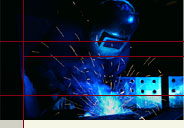
Aftermarket downpipes (DP's) deserve their own page because this is one of those "wow," seat-of-the-pants mods. Upgrading my pre-cats to downpipes was one of the most noticeable improvements I ever felt in performance from a single mod, second only to turning up the boost pressure on my turbos. Please read the site Disclaimer.
The stock pre-cats are the worst choke point in a stock Z exhaust system. They are attached to the turbochargers on one end, and then connected downstream to the midpipes or test pipes. They were designed to help control exhaust emissions at idle and during a cold start-up. Z's pass smog inspection all the time without pre-cats as long as the main catalytic converters are still in place.
The performance improvement from replacing the pre-cats with downpipes (DP's) comes from improved exhaust flow. This allows the turbo chargers to spool up sooner and put more power underfoot at lower RPMs.
The stock pre-cats are a bitch to get to in the cramped Z engine bay. The method of choice for installing aftermarket DP's is to drop the transmission, although it is possible to do so with the tranny still in the car. Better to time a downpipe install with a clutch change when the tranny has to be dropped anyway.
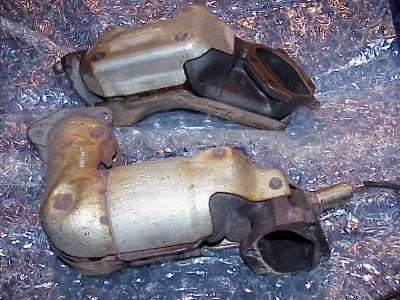 A pair of stock pre-cats with the O2 sensor still attached to the lower unit. Both pre-cats use O2 sensors. The left O2 sensor is 1/2 the price of the right, but the left fits both sides. A pair of stock pre-cats with the O2 sensor still attached to the lower unit. Both pre-cats use O2 sensors. The left O2 sensor is 1/2 the price of the right, but the left fits both sides.
Whether gutting pre-cats or upgrading to downpipes, that is the time to buy new oxygen sensors to replace the old ones. I have been told but have not confirmed that Bosch #13091 O2 sensor is the exact same sensor as what is sold as OEM, and is cheaper still.
Notice the right angle bends. Not good for exhaust flow. Stock pre-cats can be "gutted." The ceramic brick and catalytic material inside the pre-cats can broken up, pushed, prodded and pulled out. I've heard the tool of choice is a broomstick. This is a lot cheaper than buying downpipes, but is considered a ghetto mod with not near the same improvement in performance as a pair of high quality, smooth downpipes. Aftermarket downpipes smooth out the right angle bends and get rid of the restrictive catalytic brick material inside.
Downpipes have basically evolved through four "generations" of design improvements since I have been following Z cars.
- 0 = stock precats, maybe gutted
- 1st generation = single pipe DP's
- 2nd generation = partial split or "divorced" DP's
- 3rd generation = fully split or "super split" DP's
- 4th generation = 3 inch expansion DP's
Each generation of DP retained the benefits of the prior DP's while adding a new design feature. The important point to remember is that all the aftermarket DP's represent a quantum leap in design and performance over the stock pre-cats.
Here is a pic of 1st generation, four-bolt single tube DP's. I am not sure these DP's are even sold on the market anymore. The benefits over the stock precats are obvious. The right angle bends were smoothed out and the catalytic material inside is gone.
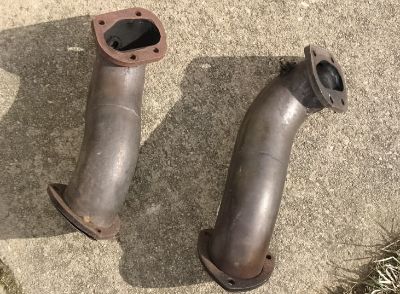 Photo courtesy of Dee Anthony Ridgeway. Photo courtesy of Dee Anthony Ridgeway.
Next are the 2nd generation "divorced" style DP's.
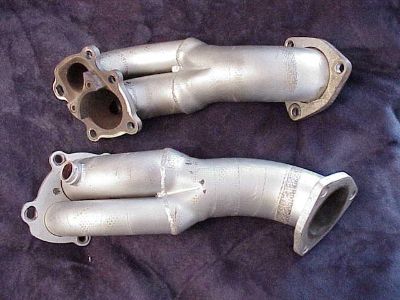 Notice the turbo flange has five bolt holes. These DP's would not fit stock turbos which are four-bolt. These DP's were wrapped in exhaust tape which left some rough marks on the surface. Notice the turbo flange has five bolt holes. These DP's would not fit stock turbos which are four-bolt. These DP's were wrapped in exhaust tape which left some rough marks on the surface.
I don't recommend wrapping DP's in thermal tape. There is a brief discussion on this at the end of this article, but whether or not to wrap is mostly personal preference.
For the first time, the exhaust flow and the turbo waste gate now had separate paths as the exhaust leaves the turbo. Each DP is split in two for half its length. This decreases turbulence and improves flow over the single tube 1st generation DP's.
Before buying downpipes, make sure the number of bolt holes on the turbo housing match up to the DP, either four of five. Four-hole DP's fit stock turbos as well as JWT Sport 500's, 600’s, Z1 GT 500’s 525’s, and any other Garrett 4-bolt turbine housings. Five-bolt flanges are found on Garrett's line of GT2xx, JWT 530s, 650s, 700s, HKS 2530s, Z1 GT 600R, Z1 GT675RS, and Z1 GT725R series turbos.
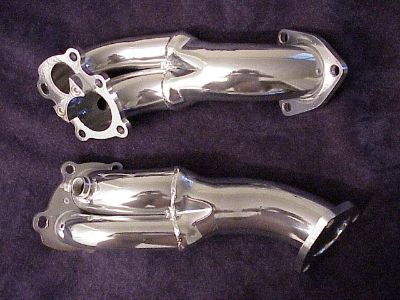 Same DP's above after Jet-Hot Sterling thermal coating. Essentially, better than new. In 2003, Jet Hot charged me $58. Same DP's above after Jet-Hot Sterling thermal coating. Essentially, better than new. In 2003, Jet Hot charged me $58.
By 2005, the cost increased to $112. At that price, I'm not sure if it's worth it anymore. I plan on trying a different type of thermal coating next time, maybe Swain.
Here is a pic of a pair of "3rd generation" DP's in aluminized steel. The waste gate and exhaust tubing are now split the full length of the pipe.
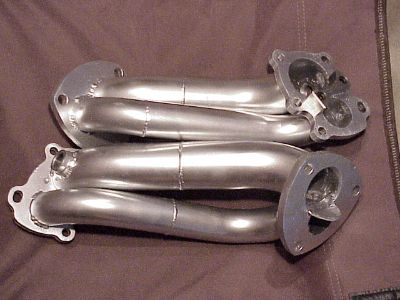 These are sometimes referred to as being "super-splits" or "true-split." The waste gate flow and exhaust flow are now completely separate for the entire length of the DP. These are sometimes referred to as being "super-splits" or "true-split." The waste gate flow and exhaust flow are now completely separate for the entire length of the DP.
Here are fourth generation downpipes, in stainless steel. This is the set I have installed on my car. They are bolted up to my JWT 530 BB turbos so the flange is five-bolt. In addition to the split still being the full length of the DP, the diameter at the downstream end has been increased to three inches. This means the midpipe flange downstream from these also must be three inches. These are the most expensive DP's plus they require an additional upgrade purchase for the next exhaust piece downstream.
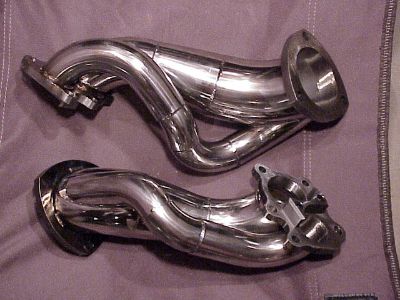 These are sometimes referred to as "expansion" DP's as the diameter of the DP increases as it leaves the turbo, shown more clearly below. These are sometimes referred to as "expansion" DP's as the diameter of the DP increases as it leaves the turbo, shown more clearly below.
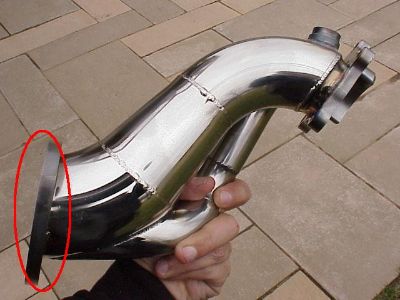 Same 4th generation DP as above, different view. These DP's require an aftermarket mid-pipe downstream that is also three inches in diameter. Stock mid-pipes are 2.5 inches. Same 4th generation DP as above, different view. These DP's require an aftermarket mid-pipe downstream that is also three inches in diameter. Stock mid-pipes are 2.5 inches.
The increments of improvement in performance are much smaller after the divorced DP's. For the money and for stock turbos, I would recommend finding a pair of used 2nd or 3rd generation DP's and get ninety percent of the benefit at a quarter of the cost.

Wrapping exhaust components such as manifolds and downpipes is a well established mod for controlling heat in the engine bay, and improving exhaust gas flow in many different types of race cars. The exact physics are complicated and over my head, but I do not wrap my downpipes, mainy because of the turbochargers.
A turbocharger's turbine is driven by the DIFFERENCE in pressure between the exhaust manifold and down-pipe. One theory is that you want more heat radiating off the pipes (the "Don't Wrap" school) which would theoretically create a larger temp gradient before and after the turbos, which would lead to a larger pressure difference and therefore improve exhaust flow and turbo spool.
Then there is the other theory which takes into consideration the flow dynamics of hot gasses, which suggests that the hotter that gas, the faster and better the flow. Those folks want to keep the temps trapped in the DP's (the "Do Wrap" school).
Some folks wrap DP's because they want to minimize underhood temps. But the hottest part of the exhaust system are the manifolds (about 500 degrees hotter than the DP's) which are still baking under the hood. There are those who swear their underhood temps go down with wrapping the DP's, but as of yet no one has taped a thermometer under the hood and documented the difference.
I am not aware of any dyno measurements that show a difference between wrapping and not wrapping the DP's.
The last issue in my mind was longevity of the pipes themselves. Some folks feel wrapping helps this. But then there are others who say that wrapping the DP's may trap moisture that condenses when the pipes cool down which could lead to corrosion.
There are valid arguments on both sides of the wrapping issue. I decided not to wrap my downpipes on the basis of simplicity and because of the reasons outlined above. The manufacturer of my downpipes also did not recommend wrapping them.
| 